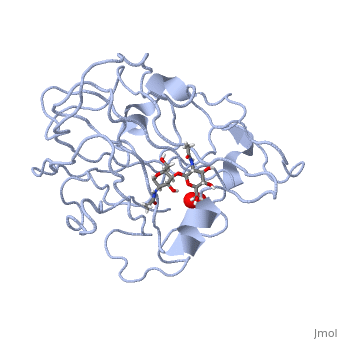Monooxygenase
FunctionMonooxygenases (MO) catalyzes the incorporation of a hydroxyl group into a variety of substrates. MO catalyzes the reduction of O2 to H2O while oxidating NADPH.
Peptidylglycine α-Hydroxylating Monooxygenase (PHM)-coordination of peroxide to CuM center. Structural and computational study [5]In recent years there has been a significant interest in describing the interactions of copper-containing enzymes with O2/H2O2-derived species. The short-lived intermediates resulting from the activation of dioxygen are the key players in the mechanistic cycles in many metalloenzymes. In the enzyme various reduced Cu/oxygen species have been proposed to act as catalytically competent intermediates, yet their exact nature and their role in the enzymatic reaction is still unknown. Structural and other studies showed that peptidylglycine α-hydroxylating monooxygenase (PHM) contains . CuM serves as an oxygen binding and hydrogen abstraction site, CuH is involved in electron transfer. In the structure of Cu(II)-PHM complexed with hydrogen peroxide determined to 1.98 Å resolution, . The Å. This Cu(II)-bound , forming . DFT and QM/MM calculations indicate that this species is a Cu-bound doubly deprotonated peroxidate and that its energy is similar to that of its isomer Cu(I)-bound superoxide. 3D structures of monooxygenase
|
| ||||||||||
ReferencesReferences
- ↑ Sciara G, Kendrew SG, Miele AE, Marsh NG, Federici L, Malatesta F, Schimperna G, Savino C, Vallone B. The structure of ActVA-Orf6, a novel type of monooxygenase involved in actinorhodin biosynthesis. EMBO J. 2003 Jan 15;22(2):205-15. PMID:12514126 doi:http://dx.doi.org/10.1093/emboj/cdg031
- ↑ Fraaije MW, Wu J, Heuts DP, van Hellemond EW, Spelberg JH, Janssen DB. Discovery of a thermostable Baeyer-Villiger monooxygenase by genome mining. Appl Microbiol Biotechnol. 2005 Jan;66(4):393-400. PMID:15599520 doi:10.1007/s00253-004-1749-5
- ↑ Benitez AR, Tweedy S, Baker Dockrey SA, Lukowski AL, Wymore T, Khare D, Brooks CL 3rd, Palfey BA, Smith JL, Narayan ARH. Structural basis for selectivity in flavin-dependent monooxygenase-catalyzed oxidative dearomatization. ACS Catal. 2019 Apr 5;9(4):3633-3640. doi: 10.1021/acscatal.8b04575. Epub 2019, Mar 25. PMID:31346489 doi:http://dx.doi.org/10.1021/acscatal.8b04575
- ↑ Yang W, Moore IF, Koteva KP, Bareich DC, Hughes DW, Wright GD. TetX is a flavin-dependent monooxygenase conferring resistance to tetracycline antibiotics. J Biol Chem. 2004 Dec 10;279(50):52346-52. doi: 10.1074/jbc.M409573200. Epub 2004, Sep 27. PMID:15452119 doi:http://dx.doi.org/10.1074/jbc.M409573200
- ↑ Rudzka K, Moreno DM, Eipper B, Mains R, Estrin DA, Amzel LM. Coordination of peroxide to the Cu(M) center of peptidylglycine alpha-hydroxylating monooxygenase (PHM): structural and computational study. J Biol Inorg Chem. 2012 Dec 18. PMID:23247335 doi:10.1007/s00775-012-0967-z
